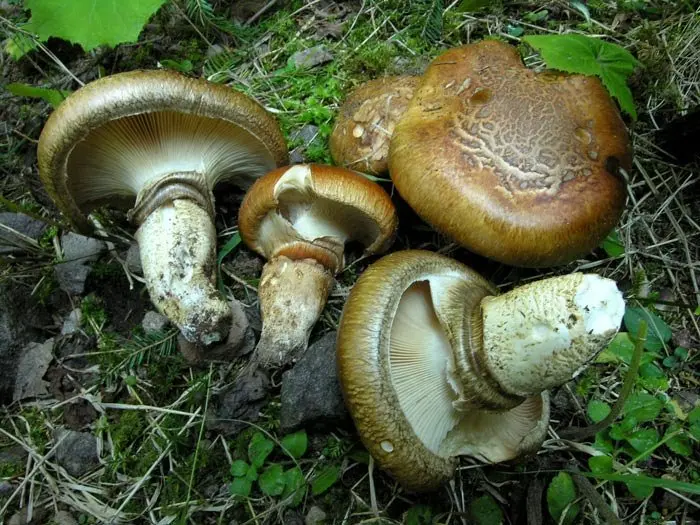Imperial catatelasma (Catathelasma imperiale)
- Division: Basidiomycota (Basidiomycetes)
- Subdivision: Agaricomycotina (Agaricomycetes)
- Class: Agaricomycetes (Agaricomycetes)
- Subclass: Agaricomycetidae (Agaricomycetes)
- Order: Agaricales (Agaric or Lamellar)
- Family: Catathelasmataceae (Catatelasma)
- Genus: Catathelasma (Katatelasma)
- Type: Catathelasma imperiale (Catatelasma imperial)

Such a mushroom Catatelasma imperial many still call imperial champignon.
Hat: 10-40 cm; in young mushrooms it is convex and sticky, later it becomes plano-convex or almost flat and dry; with crumbling fibers or scales. Dark brown to brown, reddish brown or yellowish brown in color, the cap surface often cracks when mature.
Blades: Decurrent, whitish or slightly yellowish, sometimes discoloring to gray with age.
Stem: up to 18 cm long and 8 cm wide, tapering towards the base, and usually deeply rooted, sometimes almost completely underground. The color above the ring is whitish, below the ring is brownish. The ring is double hanging down. The upper ring is the remains of a coverlet, often wrinkled, and the lower ring is the remains of a common coverlet, which collapses rather quickly, so in adult mushrooms the second ring can only be guessed.
Flesh: White, tough, firm, does not change color when exposed.
Odor and Taste: Raw mushrooms have a pronounced powdery taste; the smell is strongly powdery. After heat treatment, the taste and smell of flour completely disappear.
Spore Powder: White.
The main feature is in a rather interesting appearance, as well as in an impressive size. While the mushroom is young, it has a yellowish tint. However, when fully ripe it darkens to brown. The cap is slightly convex and thick enough, it is located on a very powerful stem, which at the base of the cap is even too thick and dense. Catatelasma imperial smooth, may have small brown spots on the stem and uneven color of the cap.
You can find this amazing mushroom only in the eastern part, in mountainous areas, most often in the Alps. Locals meet him from July to mid-autumn. This mushroom can be easily eaten in any form. It is quite tasty, without pronounced shades, ideal as an addition to some dish.
Ecology: Presumably mycorrhizal. It occurs from the second half of summer and autumn alone or in small groups on the ground under coniferous trees. Prefers to grow under the Engelman spruce and rough fir (subalpine).
Microscopic examination: Spores 10-15 x 4-6 microns, smooth, oblong-elliptical, starchy. Basidia about 75 microns or more.
Similar species: Swollen catatelasma (Sakhalin champignon), differs from imperial champignon in slightly smaller size, color and lack of flour smell and taste.










please put my name on my photo of Imperial Catathelasma imperiale. Thanks